Robotics: Design and Effectors (Sensors and Control Consideration)
A report presentation for Electronic and Communication Engineering (ECE-617) - Design and Effectors (Sensors and Control Consideration).

Introduction
Aside from the robot itself, the most critical device in a robotic automation system is the end effector. Basic grasping end effector forms are referred to as grippers. Designs for end effectors are numerous as the applications employing robots. End effectors can be part of the robot’s integral design or added-on to the base robot. The design depends on the particular robot being implemented, objects to be grasped, tasks to be performed, and the robot work environment.
Related Research



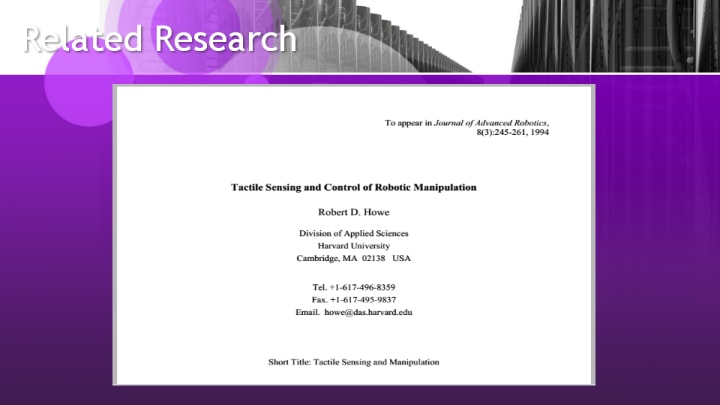
Sensors and Control Considerations
A variety of sensors is available for inclusion in end effectors. The most common sensors employed in end effectors measure proximity, collision, and force.
Proximity Sensors
Through a beam and reflective optical proximity sensors are widely used to verify the grasping of an object. Typically the sensors are used as presence indicators. The weight of the sensor on the end effector should be minimized because of payload considerations. Most optical proximity sensors are available with an optical fiber end connection so that sensor electronics will not necessarily be located on the end effector. A common implementation of this is the use of Hall effect or reed switches with air cylinder pistons.
Inductive and capacitive proximity sensors may be used with compatible object materials such as carbon steels. If a non-contact distance measurement is required rather than a presence verification, laser diode-based analog sensors or a machine vision sensor can be used. For extremely close-range and precise measurements (such as part dimensional measurements) eddy current sensors may be used on metallic components.
Collision Sensors
Collision detection sensor can be a good end effector component to mitigate damage to the robot, inserted part, or workpiece where the part is being attached. Collision detection sensors detect the first onset of a collision in all directions. After detecting the start of a collision, the robot can be stopped or backed away before damage has occurred. (Note that while proximity sensors can also be used as collision avoidance devices, most are unidirectional with a limited field of view.) Collision detection devices are usually attached at the end of the arm before the end effector.
There are several types of collision detection sensors available for wrist mounting. These include force sensors as an active control device. Force sensors are primarily strained gauge devices and require additional programming for monitoring and control. Specific collision detection sensors are readily available in the market place. These are passive devices. Some utilize compressed air for the variability of fault loading in three-dimensional space. Other collision sensor designs are based on mechanical springs at preset loads.
Tactile Feedback/Force Sensing
Force sensing during grasping is important for successful grasping of varying parts, compliant part, and reduction of part deformation. In the past strain gauge sensors were the primary device used. These, however, are of limited use in the multiple-point force sensing. Piezoelectric force sensors are also available but are better for measuring dynamic loads because of charge leakage.
Piezo resistor force sensors can be used for tactile force sensing using the principle that the resistance of silicon-implanted piezo resistors will increase when the resistors flex under any applied force. The sensor concentrates the applied force through a stainless steel plunger directly onto the silicon sensing element. The amount of resistance changes in proportion to the amount of force being applied. This change in circuit resistance results in a corresponding mV output level.
Acceleration Control for Payload Limits
Another important control aspect is the force caused during acceleration. Thus, the accelerations of the joints must be known and prescribed (or carefully estimated). In most instances the acceleration limits on each joint are known. Typically accelerations are defined by S-curves for velocity, with maximum accelerations limits.
Tactile Force Control
Traditional position and velocity control for trajectories are important for painting, welding, and deburring robots. However, to create quality products, it is also necessary to have force control for material removal operations such as grinding and deburring.
In this situation, the compliance of the robot, end effector, and tool make up total compliance (flexibility). When a tool is moved against an object, the inverse of this compliance (stiffness) creates a force. To assure that dimensional accuracy is maintained, additional position measurement of the tooltip must be made or position must be taken into account by the use of a compliance model. The stiffness of each joint is easily determined. However, each unique position of the joints creates a unique stiffness.
Generally, fixed-gain controllers (such as PID-type controllers) are preferred for force applications because of their simplicity in implementation. These controllers are easily tuned using standard approaches.
Tuning the force control loop is best done using position control and the effective stiffness from the end effector-work piece interaction. Many industrial controllers provide utilities for automatic tuning of position loops. Many are based on the Ziegler-Nichols PID tuning [25] or other heuristic techniques. Although this technique is based on continuous systems for very fast sampling rates (greater than 20 times the desired bandwidth), the results also apply well to discrete systems.
Other Types of Sensors
Internal Sensor
It is part of the robot. Internal sensors measure the robot's internal state. They are used to measure position, velocity, and acceleration of the robot joint or end effectors.
Velocity Sensor
A velocity or speed sensor measures consecutive position measurements at known intervals and computes the time rate of change in the position values.
Light Sensor
A Light Sensor is used to detect light and create a voltage difference. The two main light sensors generally used in robots are Photoresistor and Photovoltaic cells.
Sound Sensor
This sensor (generally a microphone) detects sound and returns a voltage proportional to the sound level. A simple robot can be designed to navigate based on the sound it receives.
Temperature Sensor
What if your robot has to work in a desert and transmit ambient temperature? Few generally used temperature sensor IC’s are LM34, LM35, TMP35, TMP36, and TMP37.
Contact Sensor
Contact sensors are those which require physical contact against other objects to trigger. A push-button switch, limit switch, or tactile bumper switch are all examples of contact sensors.
Proximity Sensor
This is a type of sensor that can detect the presence of a nearby object within a given distance, without any physical contact.
Distance Sensor
Most proximity sensors can also be used as distance sensors, or commonly known as Range Sensors; IR transceivers and Ultrasonic Sensors are best suited for distance measurement.
Pressure Sensor
A pressure sensor measures pressure. Tactile pressure sensors are useful in robotics as they are sensitive to touch, force, and pressure.
Tilt Sensor
Tilt sensors measure the tilt of an object. In a typical analog tilt sensor, a small amount of mercury is suspended in a glass bulb. When mercury flows towards one end, it closes, a switch which suggests a tilt.
Navigation/Positioning Sensor
Positioning sensors are used to approximate the position of a robot, some for indoor positioning, and a few others for outdoor positioning.
Acceleration Sensor
An accelerometer is a device that measures acceleration and tilt.
Voltage Sensor
Voltage sensors typically convert lower voltages to higher voltages or vice versa. One example is a general Operational-Amplifier (Op-Amp), which accepts a low voltage, amplifies it, and generates a higher voltage output.
Current Sensor
Current sensors are electronic circuits which monitor the current flow in a circuit and output either a proportional voltage or current.
Example s
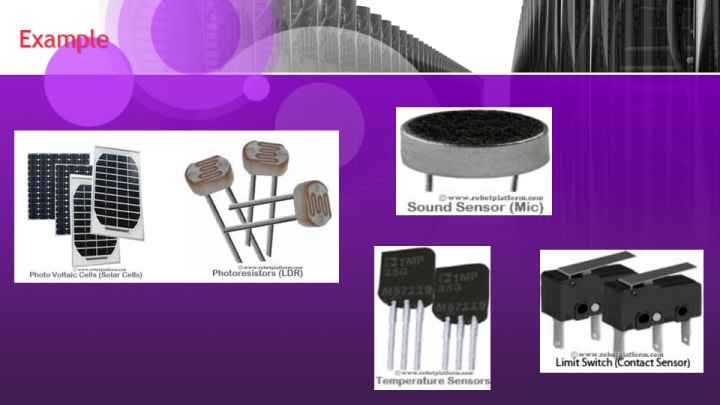
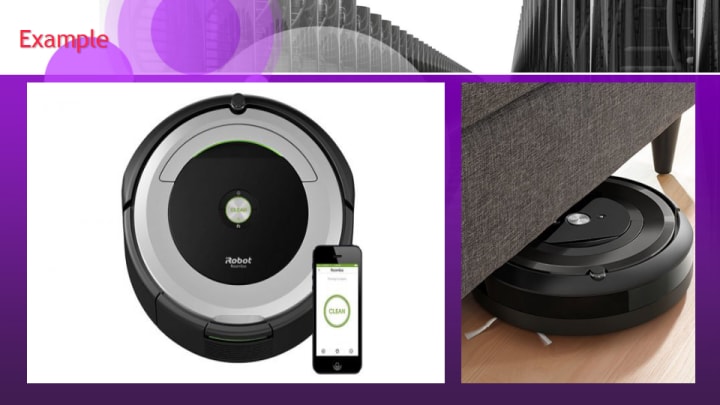
Two Types of Control Systems
1. Open Loop
Give the command to actuators based on some calculations and assume that everything is going with the theme.
2. Closed Loop
Use some sensors for getting information on the position of links or any part of a robot for considering it for calculating error, which gives us a real-time analysis.
Two Types of Controlling (Automation)
1. Servo Control
Control the robot from the error signal or setpoint signal.
2. Regular Control
Controlled by the disturbances.
Four types of robot control
1. Point-to-point (PTP) control robot
2. Continuous-path (CP) control robot
3. Controlled-path robot
4. Stop-to-Stop
Point-to-point (PTP) control robot
The PTP robot is capable of moving from one point to another point. The locations are recorded in the control memory.
Common applications include:
Component insertion
Spot welding
Hole drilling
Machine loading and unloading
Assembly operations
Continuous-Path Control Robot (CP)
The CP robot is capable of performing movements along the controlled path. With CP from one control, the robot can stop at any specified point along the controlled path.
Typical applications include:
Spray painting
Finishing
Gluing
Arc welding operations
Controlled-Path Robot
In controlled-path robots, the control equipment can generate paths of different geometry such as straight lines, circles, and interpolated curves with a high degree of accuracy.
Stop-to-Stop
1. It is an open-loop system.
2. Position and velocity unknown to the controller.
3. On/off commands stored as valve states.
4. End travel set by mechanical.
Robot Control Methods
PC Control
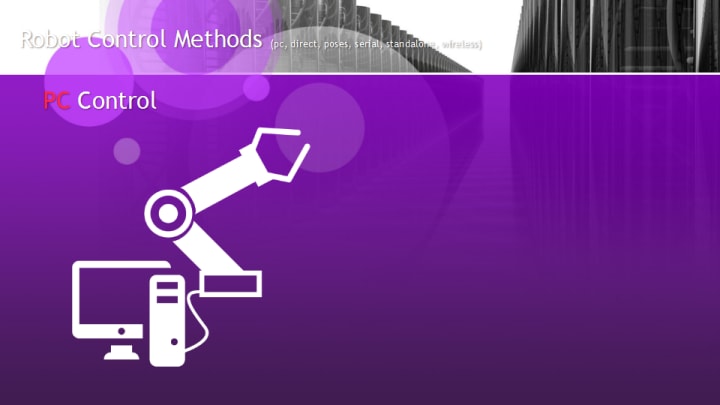
These demos and projects allow the robot to be controlled via a computer. This may be as simple as issuing commands in the Arduino Serial Monitor.
Direct Control

These demos and projects control the Robot directly from sensors connected directly to the Robot's control board. Usually, this will allow the user to directly control the robot via the sensors.
Poses Control
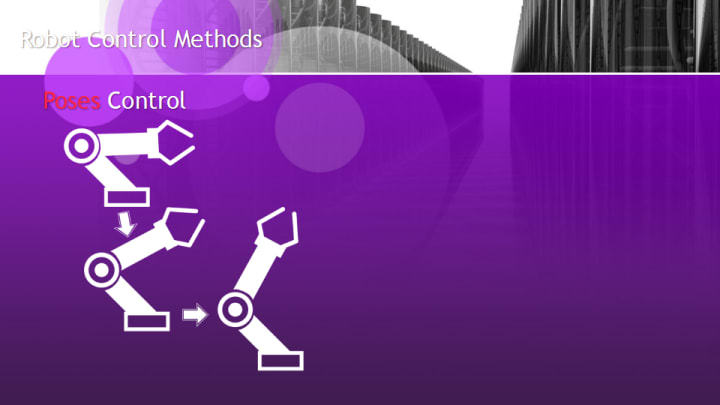
These demos and projects allow you to create and playback a sequence of poses. The pre-programmed movements can be useful for well defined, repetitive tasks.
Serial Control

These demos and projects control the robot using a serial packet protocol. A serial packet can be sent from a variety of devices ranging from computers to microcontrollers. These demos are a great place to start if you want to control the robot dynamically from another device.
Standalone

These demos and projects are designed to let your robot function without a computer or additional microcontroller. A computer will be required to set up and program the robot, but after that, no computer will be required.
Wireless Control
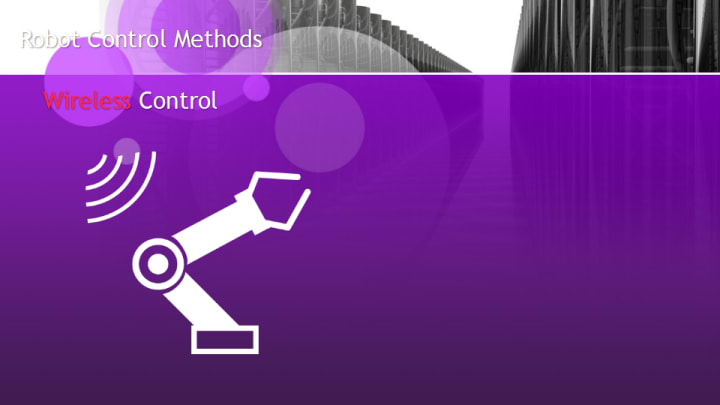
These demos and projects allow you to control the robot wirelessly.
Conclusions
From the preceding text, it is clear that the design, selection, control, and successful implementation of a robotic system relies heavily on the end effector subsystem. End effector designs and technology continue to evolve with new actuators, sensors, and devices.

References
Adept Technologies. (2003). AdeptSix 300 Specifications Data Sheet.
Baumeister, T. (1978). Marks’ Standard Handbook for Mechanical Engineers, 8th ed., McGraw-Hill, New York, 6–24.
Bicchi, A. (2000). Hands for dexterous manipulation and robust grasping: a difficult road toward simplicity, IEEE Trans. Robot. Autom.,16, 652.
Bicchi, A., & Kumar, V. (2000). Robotic grasping and contact: a review, IEEE Int. Conf. Robot. Autom., 200, 348.
Caldwell, D.G., & Tsagarakis, N. (2000). Soft grasping using a dexterous hand, Indust. Robot, 3, 194.
Causey, G. C., & Quinn, R. R. (1998). Gripper design guidelines for modular manufacturing, IEEE Int. Conf. Robot. Autom., 1453.
Ceglarek, D., Li, H.F., & Tang, Y. (2001). Modeling and optimization of end effector layout for handling compliant sheet metal parts, J. Manuf. Sci. Eng., 123, 473.
Ciblak, N. (1998). Analysis of Cartesian stiffness and compliance with applications, Ph.D. Thesis Defense, Georgia Institute of Technology.
Derby, S., & McFadden, J. (2002). A high precision robotic docking end effector: the dockbot(TM), Ind. Robot, 29, 354.
Foster, A., Akin, D., & Carignan, C. (2002). Development of a four-fingered dexterous robot end-effector for space operations, IEEE Int. Conf. Robot. Autom., 3, 2302–2308.
Francois, C., Ikeuchi, K., & Herbert, M. (1991). A three finger gripper for manipulation in unstructured Environments, IEEE Int. Conf. Robot. Autom., 3, 2261–2265.
Franklin, G. F., Powell, J. D., & Workman, M. L. (1990). Digital Control of Dynamic Systems, Addison- Wesley, Reading, MA.
Interlink Electronics. (2003). FSR Data sheet.
Kane, T. R. (1985). Dynamics: Theory and Applications, McGraw-Hill, New York.
Kaneko, M. et al. (1999). Grasp and manipulation for multiple objects, Adv. Robot., 13, 353.
Kumazaki, K. et al. (2002). A study of the stable grasping by a redundant multi-fingered robot hand, SICE, 631.
Mason, M., & Salisbury, J. (1985). Robotic Hands and the Mechanics of Manipulation, MIT Press, Boston.
Robotic Accessories (2003). Alignment Device 1718 Specifications.
Seguna, C.M., The design, construction and testing of a dexterous robotic end effector, IEEE SPC, 2001.
Taylor, C. L., & Schwarz, R. J. (1955). The Anatomy and Mechanics of the Human Hand: Artificial Limbs, vol. 2, 22–35.
Thermo CRS (2003). A465 Six Axis Robot Specification.
Walsh, S. (1984). Gripper design: guidelines for effective results, Manuf. Eng., 93, 53.
Yang, K., & Gu, C. L. (2002). A novel robot hand with embedded shape memory alloy actuators, J. Mech. Eng. Sci., 216, 737.
Zajac, T. (2003). Robotic gripper sizing: the science, technology and lore, ZAYTRAN.
Zhang, T., & Goldberg, K. (2001). Design of robot gripper jaws based on trapezoidal modules, IEEE Int. Conf. Robot. Autom., 29, 354.
About the Creator
Domingo Añasco-Gaces Samontina, Jr.
.Professional Member of the Mechatronics and Robotics Society of the Philippines
.Certified Documented Information Controller with TUV Rheinland Qualifications
.Master of Science in Engineering (on-going) with Professional Teacher Certificate

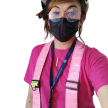




Comments
There are no comments for this story
Be the first to respond and start the conversation.